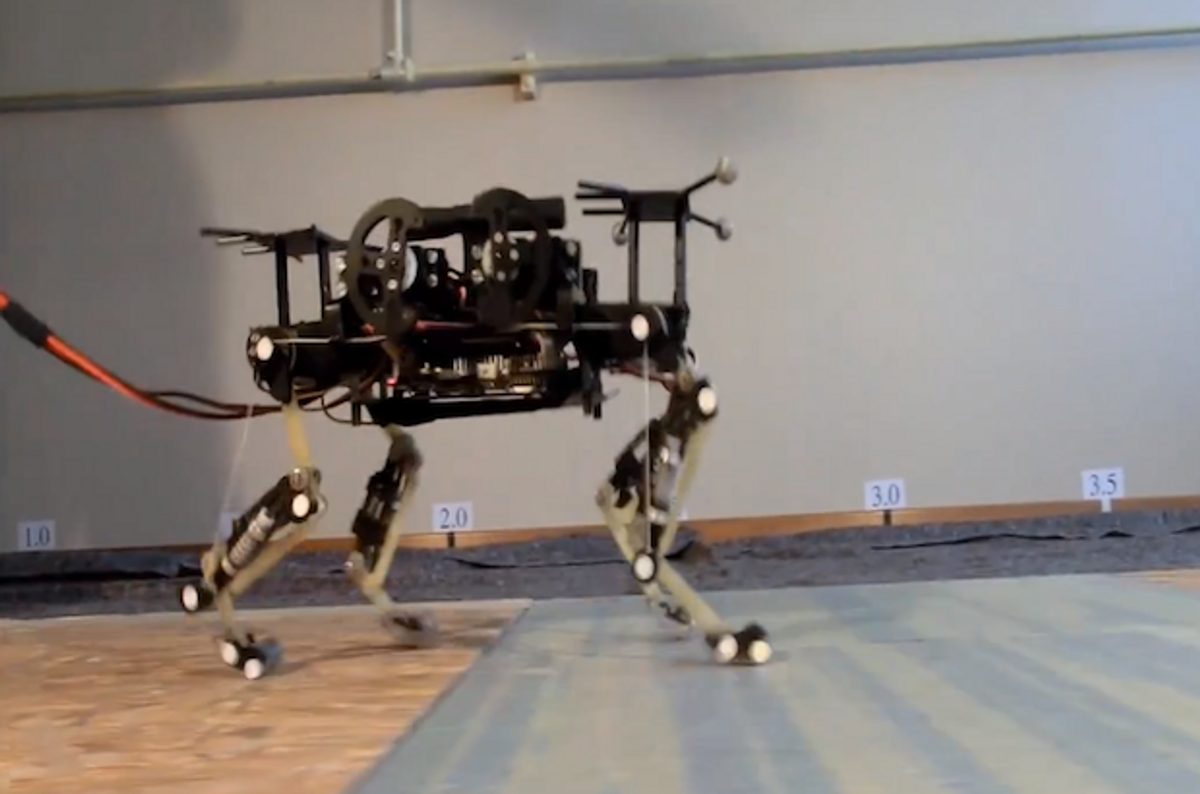The rising interest in quadrupeds over the past few years has led to the development of several exciting new projects based on Cheetahs. One such robot is Cheetah-Cub, a compliant quadruped developed at the Biorobotics lab at the EPFL, the Swiss Federal Institute of Technology in Lausanne. To put Cheetah-Cub in motion, the EPFL group teamed up with researchers from the Italian Institute of Technology (IIT), who have recently managed to transfer horse-like locomotion to the robot.
EPFL's Cheetah-Cub quadruped, which weighs just 1.1 kg (2.4 lb) and is about the size of a housecat, is powered by Kondo KRS2350 hobby servos. It's a compliant robot that, like IIT's COMAN humanoid, is part of the AMARSi (Adaptive Modular Architectures for Rich Motor Skills) project, which seeks to "improve biological richness of robotic motor skills." The Cheetah-Cub itself will be described in a paper soon to be published in the International Journal of Robotics Research, so for now we're going to look at how the team at IIT made it move like a horse, using an approach different from their previous work with the hydraulic quadruped HyQ.
Developing walking gaits for multi-legged robots can be tricky. To solve the problem, many robots use a simple neural network called a Central Pattern Generator, or CPG, to produce rhythmic leg motion. The aim is to obtain robust locomotion patterns that exhibit stable limit cycles—periodic patterns that can resist perturbations. The robustness is obtained by providing feedback to the CPG from sensors in the legs or feet of the robot to compensate for irregularities and obstacles on the ground. It's a bit like a simple cockroach that, despite its size, is quite capable of crawling over most any terrain.
In recent years researchers have developed a way to break down the CPG into what are called kinematic Motion Primitives (kMPs). With some work, the kMPs found in the walking gaits observed in animals can be adapted to robots with the same number of limbs—a kind of refined CPG. For example, IIT's COMAN humanoid robot got its walking gait from kMPs extracted from human walking data.
For Cheetah-Cub, the team at IIT used motion-capture data from U.K company Kinetic Impulse. The data showed the joint trajectories of a horse walking, trotting, and galloping. The researchers then extracted four kMPs from the data, creating short sequential gait cycles for each. Surprisingly, they discovered that there was only a 3 percent difference between them, writing that "a possible interpretation is that the kMPs extracted from walk, trot, and gallop are in fact the same set of kMPs, that together are sufficient to describe the three different gaits."
Although a single kMP may be at the heart of each gait, generating a gallop from a walking gait isn't possible without knowing what values to enter into the equation. To overcome this problem, the team used some mathematical transformations to adapt each of the gaits to the robot separately, taking into account the differences between the size and range of motion of the horse and the robot.
In experiments, the Cheetah-Cub walked with a speed of 0.43 meters per second (1 mph), or roughly two body lengths per second, and could trot at 0.59 m/s (1.3 mph), or 2.8 body lengths per second. The team also developed transitions between the walk and trot, allowing the robot to speed up or slow down smoothly. Unfortunately, the gallop gait wasn't quite as successful. That's because mammals flex their spine when running at high speeds, whereas Cheetah-Cub has a rigid trunk (a flexible trunk is currently in the works). As a result, the robot's feet would slip during the gallop gait.
This work shows that it's possible to derive gait primitives from motion-capture of an actual animal and adapt them to a robot. It should be interesting to see how a biomimetic robot that more closely approximates the anatomy of a specific species will benefit from kMPs derived from that species.
Details from this project are summarized from "Horse-Like Walking, Trotting, and Galloping derived from Kinematic Motion Primitives (kMPs) and their Application to Walk/Trot Transitions in a Compliant Quadruped Robot" by Federico L. Moro, Alexander Sprowitz, Alexandre Tuleu, Massimo Vespignani, Nikos G. Tsagarakis, Auke J. Ijspeert, and Darwin G. Caldwell, published in the March 2013 issue of Biological Cybernetics.




